5
Developing a Governance Structure for Blockchain Networks
A well-structured governance is the most crucial element of a successful business that drives excellence in performance and culture.
—Jai Singh Arun
Governance is concerned with rules of engagement for greater good and fairness in any system. Governance is also about rules and decision making in any system. Perhaps not surprisingly, if there are rules, there are also exceptions to those rules. Thus, governance is about coordinated decision making, and it manifests itself in different ways. For example, consensus enforces governance (equitable participation) by introducing economic incentives in trust systems, and in some cases the combination of a reputation system with consensus ensures integrity in participation.
No matter whether it is a self-governing or semi-autonomous structure, the governance of a blockchain business network defines a comprehensive set of rules, agreed to by participants, that ensure trust, transparency, control, and coordination by which the network is seamlessly designed, developed, tested, deployed, and operated. Figure 5.1 depicts the interactions that governance affects.
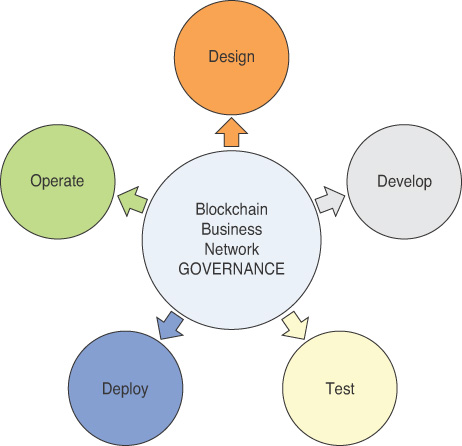
In permissioned networks, governance becomes a design imperative that must be included as a part of the network’s design. Also, it must be flexible and organic enough to morph with the ecosystem and membership changes and to respond to shifts in the business model. The technology constructs must support the dynamic nature of the governance structure and provide the least disruptive path to the collective decision-making process of the network participants. Because it permeates all aspects of the blockchain, governance is an integral component of a sustainable network.
The topic of governance imposes a collective set of challenges on both the process and political fronts. We can readily witness these challenges and the anatomy of governance structures in blockchain networks. The governance models range from self-governing networks to consortium-defined semi-autonomous governance structures. Finding the correct governance model to support the agenda of blockchain-based business networks is both an opportunity and a challenge. Indeed, governance presents an interesting paradox in the blockchain context.
As an example, consider a blockchain-presented value network that is self-governed and censorship-resistant, and whose governance structure is defined by control points and economic incentives to maintain a balance between network-based coordination and network-based decisions on transaction finality. The consensus algorithms of these decentralized networks present a distributed governance structure in which the input (transaction initiation) comes from various stakeholders (owners of assets, assigned or delegated ownership, simply delegated authority). This input consists of a transaction that goes through a series of network-based decentralized processing; the output is the decision, which takes the form of a transaction finality.
The governance structure is based on devised economic incentives that are driven by consensus and that govern the network. Thus, it is defined as the body (centralized or decentralized) whose sole responsibility is to make binding decisions in a system by establishing set of law or rules.
The genesis of blockchain relied upon technology-based systemic governance composed of incentives and mechanisms of coordination, as exemplified by the permissionless, crypto-asset–based networks operated by Bitcoin, Litecoin, and others. Nevertheless, this type of systemic governance poses a new set of challenges for enterprise business networks that attempt to use the tenets of blockchain technology. In the enterprise world, which is largely regulated and relies upon (mostly) permissioned blockchain models, the checks-and-balances system is complicated by transactions between competing entities, often with regulated data and a fiduciary responsibility, which cannot account for the tangible or systemically generated incentives (crypto assets) or have network-wide mechanisms of coordination due to privacy and confidentiality issues.
On the enterprise side of the divide, the focus should be on understanding the technology and reimagining the ecosystems, business network, regulatory compliance, confidentiality and privacy, and business models that impact industry networks. In this environment, the governance structure is an interesting challenge and emerging discipline. Indeed, in the enterprise blockchain world, the options range from full decentralization and quasi-decentralization to fully centralized blockchain networks—but the specific choice always hinges on the governance structure. The governance structure and landscape determine the interaction models, means of growth (centralized or decentralized), technology design, and overall business operations of the enterprise blockchain network. Figure 5.2 describes the differences between permissionless networks and permissioned enterprise-oriented networks.
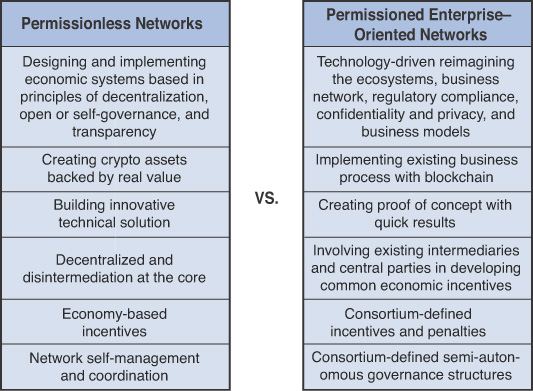
A blockchain-powered business network as digital transaction platform has the potential to facilitate the co-creation of new value and new synergies. It is a managed platform that is operated with a defined service level agreement (SLA), and has a robust governance structure that attracts new participants and sustains the confidence and business benefits of its founders and existing participants. It features a close-knit dependency on the business models and governance structure that oversee various facets of blockchain network operations. A well-thought-out governance structure for blockchain networks provides an important avenue for business continuity, funding and sourcing models, and overall growth, which is driven by the economic and financial structure of the business network and powered by the tenets of blockchain technology.
Governance Structure and Landscape
Systemic governance that relies solely on incentives and network coordination is inadequate to address more highly structured and regulated industries and their use cases. For this reason, we have taken the liberty of defining a governance structure and landscape that uses known and proven existing practices. The resulting model is modular and facilitates progression, yet also provides a layer that separates the competency concerns of the various participants.
The aim is to define a simplified governance framework that draws inspiration from the core tenets of blockchain design and incorporates a governance model that encompasses principles of game theory, incentives, penalties, flexibility, delegation, and network mechanisms of coordination. This framework uses blockchain technology to trust networks and flattens the distinction between the miner and the user. At the same time, it enforces rules of engagement that encourage technology upgrades and security updates and penalize noncompliant systems and nodes, including similar business network rules of engagement. The incentive mechanism is intended to ensure continued participation and resulting business benefits and growth for members of blockchain-powered business networks. This business governance model governs participation in business networks and an equitable cost structure that is fairly spread out among network members based on participant activity.
The three primary building blocks of a blockchain business network are technology infrastructure governance, network membership governance, and business network governance, as shown in Figure 5.3.

Technology Infrastructure Governance
Technology infrastructure governance is a discipline that focuses on IT infrastructures, performance, cost structures, technology, and business risks. It includes a set of collaborative tools, processes, and methodologies intended to ensure organizational alignment of the business strategy with the technology infrastructure and services.
The goal of technology infrastructure governance is to support, adapt, and complement the blockchain business network’s objectives. In a blockchain network, as opposed to a centralized entity, these tasks can be challenging because the governance framework should focus on specifying an accountability framework to encourage necessary behavior. In this setting, the functioning of the IT infrastructure that enables deployment and operation of that infrastructure is defined as the foundational layer of the blockchain network. Many best practices frameworks, such as Information Technology Infrastructure Library (ITIL) and Governance, Risk, and Compliance (GRC), have already laid a strong foundation for blockchain networks to build upon and create a blockchain-specific technology governance structure.
Any technical design should accommodate the flexibility of various participants when it comes to choices related to technology and infrastructure. Blockchain networks will generally aim for certain levels of decentralization or quasi-decentralization. In turn, IT governance should accommodate a model that supports distributed flexibility and distributed control.
Technology governance–related tasks include the following:
Devise a decentralized IT management structure.
Devise a model for distributed (and decentralized) maintenance, including software and hardware updates, upgrades, and path management.
Devise a framework that uses industry standards, such as COBIT, ITIL, ISO, CMMI, and FAIR, that are driven by the consortium, joint venture, or other business model.
Establish industry-specific governance, risk, and compliance (GRC) tools.
Perform consortium resource optimization, which includes choices related to technology procurement, supplier–vendor relations, SLA management, skills, and talent management.
Perform technology adoption and risk assessment, which requires keeping up with technology evolution and economic deployment models, including deployment and operational risks.
Devise a network deployment strategy. This task is not as simple as an application upgrade. Include a model that can encourage and enforce continual technology and security updates and upgrades.
Set up network support services, which are business networks. The governance model should include network support services, IT SLA enforcement, and membership services.
Perform consortium risk optimization, which includes operational support services (OSSs) and business support services (BSSs), IT infrastructure continuity services and planning, and technology alignment to legal and regulatory requirements, among other factors.
The IT governance model should encourage technology upgrades and security, and penalize noncompliant systems and nodes, so as to create an incentive mechanism to ensure continuous participation. Figure 5.4 provides a quick checklist of key elements that should be considered in technology infrastructure governance.
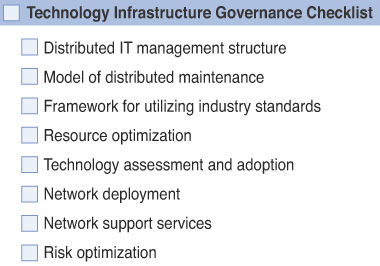
Network Membership Governance
The model of network governance in a blockchain network reflects the fact that the network is organic and composed of ecosystem players with varied business interests. In essence, it is an interactive ecosystem with common business objectives instead of a bureaucratic structure with a centralized business entity.
This model imposes extraordinary challenges on network members to maintain the balance of smooth business operation and the enforcement of engagement rules within the operating framework. In many consortium-led business structures, network governance might involve a select set of autonomous entities that are engaged in creating value, services, and digital goods, and it might use smart contracts and the blockchain as a marketplace mechanism to coordinate and safeguard the exchange of value. Therefore, the business model plays a critical role in increasing the efficiency of the operating model and reducing agency problems due to defined rules of engagement associated with both rewards and penalties.
These business governance models govern participation in business networks and create an equitable cost structure that is fairly distributed among members based on participant activity. Their structure enables autonomous and like-minded business entities to engage in business transactions, contracts, and value creation. To ensure smooth operation of the blockchain, the governance structure should include rules of engagement and social contracts that promote fair behavior and reputation systems to enforce it.
Blockchain network membership governance–related activities include the following:
Membership onboarding and offboarding: The permissioning structure and key management can include a model that has the following qualities:
Vote-driven but centrally managed
Has a federated structure in which members invite other business entities to join the network
Has a delegated structure that includes services providers that can delegate to other members
An equitable and fair cost structure.
Consortium-wide data ownership structure for business entities joining and leaving the network.
Compliance assurance services for industry-specific regulatory oversight provisioning, which includes a model to act as a delegate to generate regulatory compliance, adherence, and reporting.
A dispute resolution charter for the network.
Coordination and direction of the technology infrastructure and management.
Business network and SLA management for the blockchain business network management.
Network support services: Business networks. The governance model should include network support services, business network SLA enforcement, and membership services.
Network-specific risk optimization: A business support services structure that includes business continuity services and planning, network alignment to legal and regulatory requirements, and other items.
Figure 5.5 provides a quick checklist of key elements that should be considered in network membership governance.
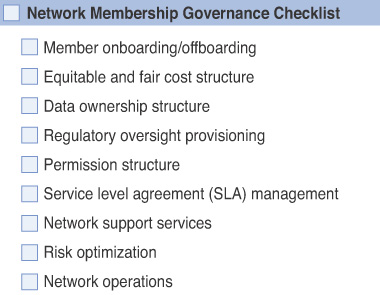
Business Network Governance
Business networks that are powered by blockchain need a governance model that is industry- and use case–specific. Also, these networks must account for various facets of the industry itself, as well as its evolution—including the change in overall governance structure. Blockchain is an important form of multi-organizational governance. Its core objective is to increase operational efficiency and reduce hurdles imposed by the agency (centralized business entity). The efficiency is enhanced by distributed data, asset- and value-related decision making, and decentralized problem solving through trust systems and consensus.
The term shared governance is often used to describe a business activity that collectively represents an industry to the various external ecosystems, such as adjunct business networks, and governmental and regulatory entities. This collective representation has advantages such as sharing of the business process costs and the market benefits conferred by arbitrage, brokerage, and attracting new ecosystem players.
One key goal of business network governance is to manage the growth of the network while maintaining the SLA and core business objectives. The governance structure includes a wider understanding of network functions, with these collective functions by various participants then leading to network outcomes. As blockchain networks evolve and grow and as new participants are added or removed, the dynamics of the network change, and both bilateral and multilateral relationships may emerge.
Co-creation is a concept that brings different parties together (e.g., a company and a group of customers) to jointly produce a mutually valued outcome. Co-creation gathers a unique blend of ideas from direct customers or viewers (who are not the direct users of the product), which then leads to a plethora of new ideas for the organizations that represent the consortium. Ideally, business network governance imperatives will seek to balance the growth and cultivate the synergies between the ecosystems so as to transform the business network by adopting new business models.
Business network governance–related tenets include the following items:
Communication and notification: Network-related charter and communication.
Synthesis of transaction costs and economies of scale: Common and shared services management, such as know your customer (KYC), audits, reporting, network operations, IT infrastructure, and flattened business processes.
Business SLAs: Quality assurance, performance, and network security.
Favorable exchange conditions: Integrity of digital assets, asset specificity, supply and demand uncertainty, and product and business network evolution.
Collective representation: Enforcement of industry-specific compliance legal and regulatory frameworks.
Structural embeddedness: Adherence to industry-specific requirements for trusted movement of assets and value in the network.
Federated governance framework: Framework, charter, and stewards of technology and network membership governance frameworks.
Business structure: Formulation of appropriate business models, legal charters, and rules of engagement for network business operations.
Figure 5.6 provides a quick checklist of key elements that should be considered in business network governance.
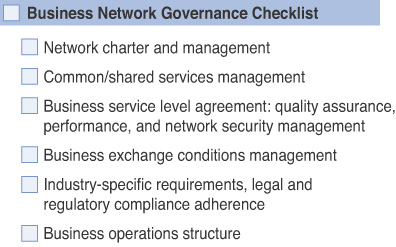
Development of governance structure is a challenging and emerging discipline in the enterprise blockchain world, where the debate around the spectrum of options—which range from full decentralization and quasi-decentralization to fully centralized blockchain networks—hinges on the governance structure selected. The governance structure and landscape determine the interaction models, growth (centralized or decentralized), technology design, and overall business operation of enterprise blockchain networks. The platform that facilitates co-creation and new synergies must be effectively managed, operate under the aegis of defined SLAs, and have a robust governance structure that attracts new participants and sustains the confidence and business benefits of its founders and existing participants.
There is a close-knit dependency between business models and governance structures that govern various facets of blockchain network operations. A well-crafted governance model will ensure balance and smooth interactions between various entities that compete with some network participants and that cooperate and co-create with some other network participants.
Although blockchain networks are decentralized by nature, the governance structure is fundamentally driven by the type of the business model (including business participants, outcomes, and incentives) that you are considering for your blockchain business network. As discussed in Chapter 4, these potential models include a joint venture, consortium, NewCo, business ecosystem, founder-led network (build, own, and operate), or founding consortium–led network (build, own, operate, and transfer).
In addition, governance models can be self-governed or semi-autonomous, managed off-chain or on-chain. Off-chain means that governance rules and policies are managed outside the blockchain; that is, after they are reviewed and approved, they are implemented on blockchain. On-chain means that governance policies and rules are managed by using smart contracts and consensus algorithms within the blockchain.
In the next section, we review an example of a governance structure in a blockchain. This structure is based on a global digital supply chain network that we refer to as SCTrustNet.
SCTrustNet
The SCTrustNet network is intended to bring end-to-end visibility, trust, transparency, and transformation to a consortium-led business model of an enterprise supply chain network, which consists of various participants including suppliers, buyers, banks, shipping carriers, freight forwarders, and regulators (custom and port authorities). As shown in Figure 5.7, the transformational business outcomes are expected to reduce cost, complexity, and latency across supply chain transactions and network.

The SCTrustNet governance structure is organized into three primary areas: business network, network membership, and technology infrastructure. Let us dive into the details of each of these areas.
Business Network Governance
The supply chain business-specific legal and financial policies and rules are governed and managed by the business network governance structure. They include the following items:
A unified charter includes the overall network’s business outcomes, participants’ contributions (costs, resources, and ecosystem), and their incentives (visibility, control, efficiency, and monetary rewards) in SCTrustNet.
The agreed business model is a consortium-led ecosystem with a set of founding members (three suppliers, three buyers, two banks, and a shipping line carrier) and nonfounding members (freight forwarders and custom and port authorities).
Founding members can order and endorse the transaction for validation and commitment. Nonfounding members can only endorse transactions.
Business contracts (purchase orders, bills of lading, letters of credit, bank guarantees, commercial invoices, and others) between buyers, suppliers, banks, and carriers are managed by using smart contracts.
SLAs for shared services, such as reporting, auditing, tracking, and tracing of assets, including penalties in quality of service, are coded on-chain.
Cross-border trader and payments regulations and compliance policies are agreed to between buyers and suppliers and added to smart contracts for transaction and fulfillment agility.
Business operations and security principles to ensure participants’ and their data’s privacy, integrity, and performance are part of the digital supply chain network.
Risk identification and mitigation policies are included in SCTrustNet.
Network Membership Governance
Network membership governance drives the overall membership management and governance of the network participants, network services, and related activities. It includes the following items:
Established rules for each type of participant, the authority to invite entities to join the network, and onboarding and offboarding of new suppliers, buyers, freight forwarders, banks, carriers, and custom and port authorities
Access and operations rights to data and transactions (purchase orders, invoices, bills of lading, and letters of credit) in the blockchain
Membership and network participation fee structures for each type of participant and their roles
Management of decentralized and shared network services, including track and trace, purchase order processing, and transportation
Penalties for not delivering services and quality and neglecting the charter of SCTrustNet
Communication policies to share the correct information with the correct participants at the correct time in the supply chain for trust and transparency
Network Infrastructure Governance
The infrastructure governance for SCTrustNet includes all the rules and regulations of the following items:
Blockchain technology (i.e., Corda, Ethereum, and Hyperledger Fabric) assessment, selection, and deployment (public and private cloud)
Setting up blockchain nodes (a system with a copy of the distributed ledger and connected in the network)
Project management, test, and deployment of chaincodes (decentralized applications) for network services
Security and access of nodes and shared services chaincodes
Autonomous execution of incentives and penalties for infrastructure service and quality assurance, and risk management
SCTrustNet infrastructure operations (server, storage, and network)
Change, upgrade, and release management of the technology
High availability, disaster recovery, and business continuity management
Capacity, scalability, and performance management policies
Incidence management, logging, and monitoring
Chapter Summary
Blockchain-based application networks are more than a technical project implementation. In our case deployment observations, the technical aspects of the blockchain, if they are well designed by using the correct skills, can be realized with a high certainty of success. To achieve this success, we need to carry out a series of business-driven activities that ensure the correct focus, enterprise resources, acumen, and organizational energy are channeled with executive commitment.
Selecting the correct use case is necessary to understand the appropriate business models and define the correct governance structure. This choice puts the focus on enterprise commitment and industry-wide influence as a means to attract other ecosystem players, which then commit to the common vision and goals of the blockchain network. The use case and resulting business economics drive the investment agenda, which enables the enterprise or consortium to focus on business models that lead to equitable and sustainable deployment and a governance structure that meets the industry-specific requirements.
Blockchain projects encompass creative strategic thinking and solve complex technology problems, which means that the correct use case must have a tight linkage between the business models and the technology blueprint. The governance model integrates a business model with the correct amount of coordination, thereby ensuring that all participants adhere to a common set of objectives, fair and equitable use of network resources, and rules of engagement.
